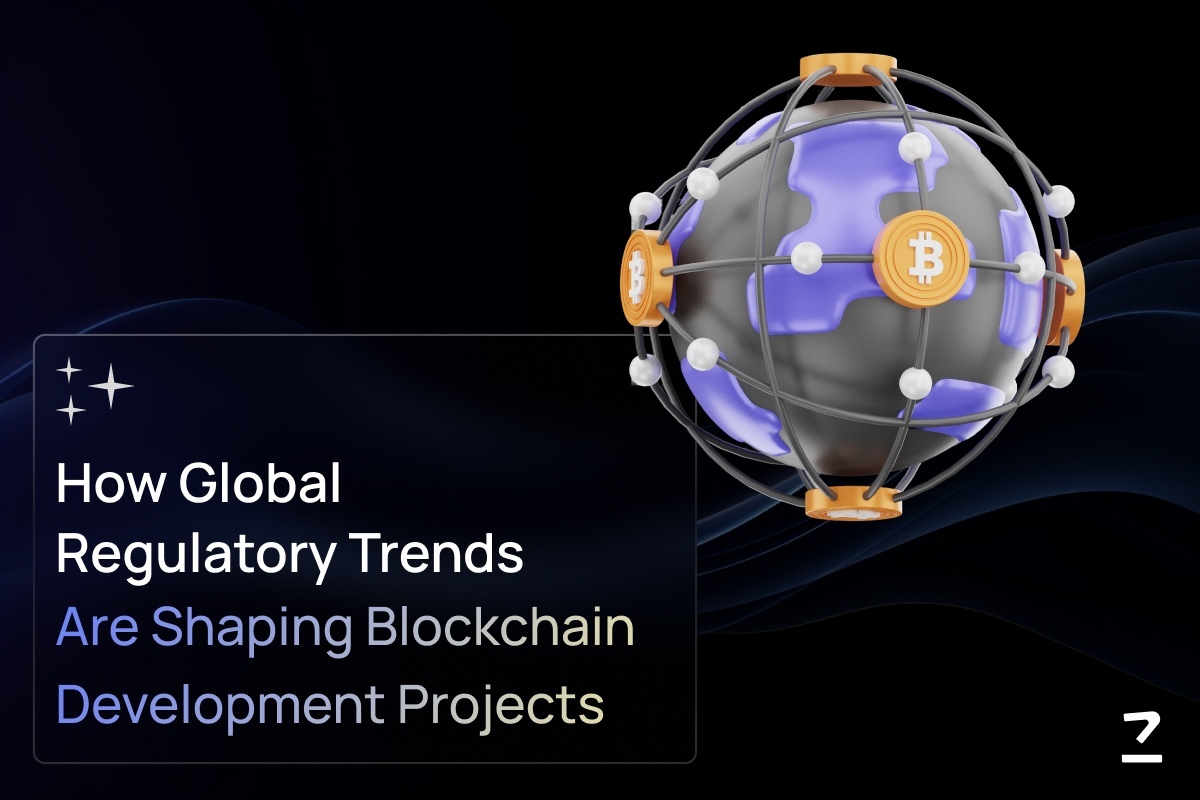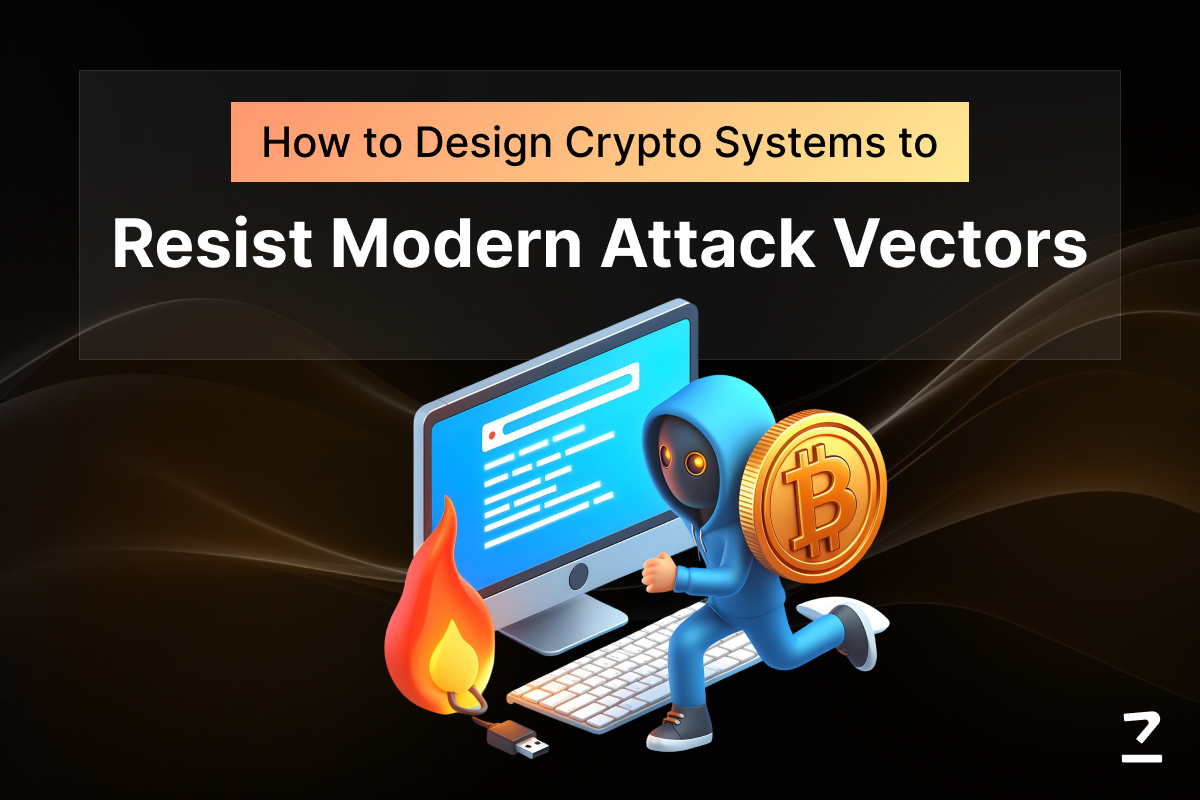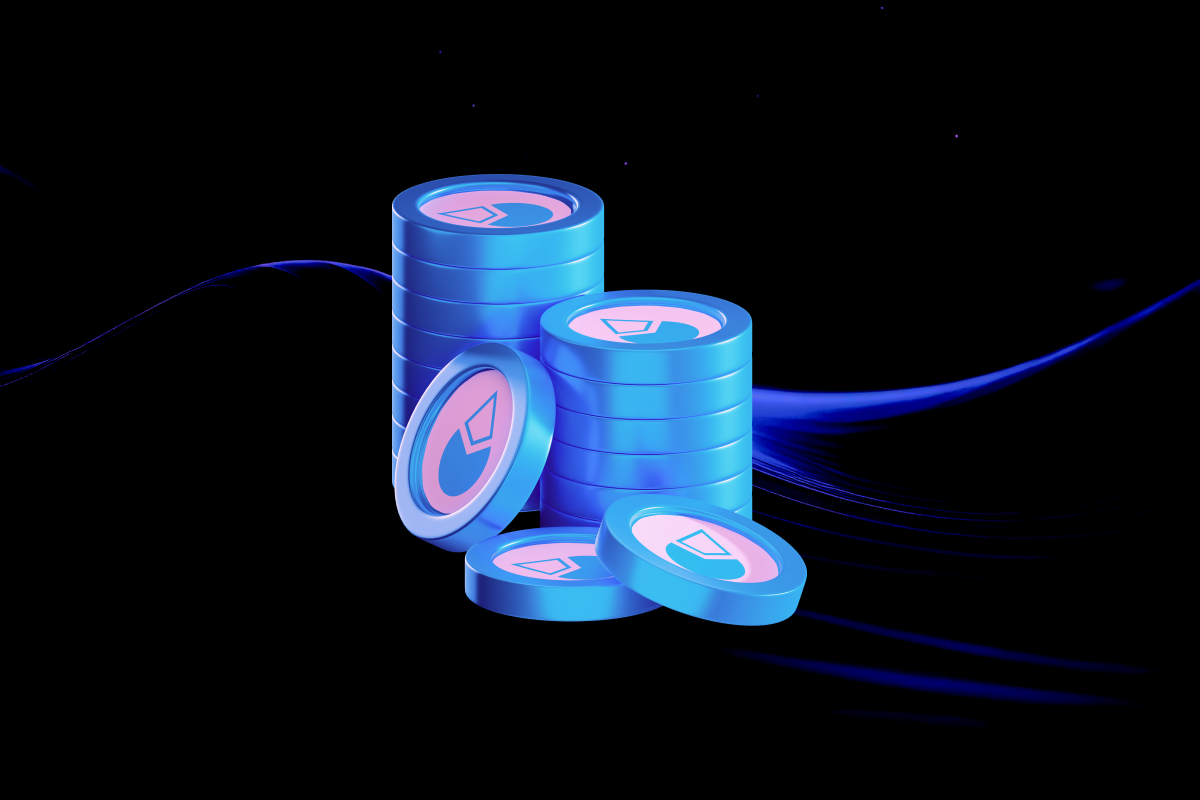SHARE THIS ARTICLE
Intent-Based Smart Contracts: The Next Evolution in Blockchain Automation
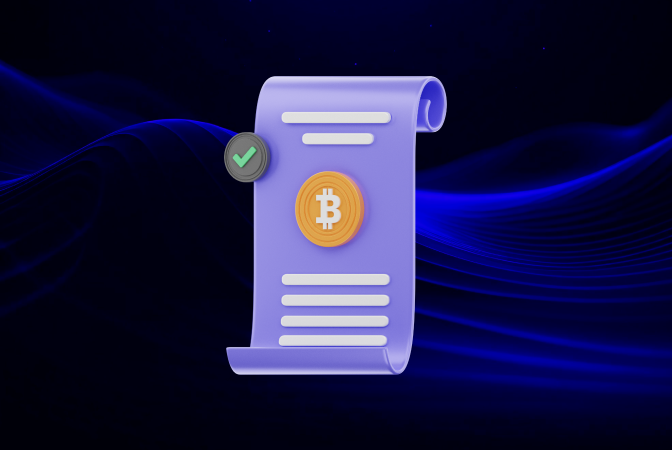
Smart contracts have come a long way since they first hit the blockchain scene. By replacing middlemen with code, they’ve made it possible to run financial transactions, DAOs, and entire applications without relying on centralized control. But there’s a catch—they’re rigid. Traditional smart contracts only work when specific, pre-set conditions are met. If something changes or falls outside that logic, the contract simply doesn’t respond.
That’s where intent-based smart contracts come in. Instead of locking in fixed conditions, these contracts focus on what the user intends to do. Powered by AI, they can adapt in real-time and respond based on context—without needing to rewrite the code every time the environment shifts.
As we move deeper into blockchain automation in 2025, this shift from static logic to intent-driven execution is starting to reshape how developers and businesses approach smart contract development.
At Codezeros, we’re building for that future. As a smart contract development company focused on practical, next-gen solutions, we’re helping teams rethink automation with smarter, more adaptable contract logic.
Traditional Smart Contracts - Where We Are Today
Most smart contracts today run on simple IF-THEN logic. If Condition A is true, then Action B takes place. It’s clean, predictable, and works well in situations where everything is known in advance.
But real-world use cases—especially in DeFi automation—rarely follow perfect conditions. Markets shift, user needs change, and unexpected inputs are common. Traditional smart contracts struggle with this because they’re coded with strict rules. They can’t adapt or make sense of intent. If the input isn’t exactly what the contract expects, it just fails or gets stuck.
This rigidity slows down innovation and limits what's possible with smart contract logic. For example, automating yield strategies or DAO governance actions often requires rewriting or redeploying contracts every time a new condition arises.
That’s why more developers and projects are starting to look beyond static code. There’s a growing demand for smart contract development services that focus on smarter automation—something that can work with context, adjust to changes, and actually understand what the user wants to achieve.
Intent-based contracts are built to meet that demand.
What Are Intent-Based Smart Contracts?
Intent-based smart contracts are built to do something traditional contracts can’t—they focus on why the user is interacting with the contract, not just what the user inputs. Instead of relying on fixed, hard-coded conditions, these contracts read the user’s intent and act accordingly.
This is made possible with the help of AI and machine learning. These systems are trained to understand patterns, preferences, and context. When someone interacts with an intent-based contract, an AI-driven smart contract interprets their action—whether it’s placing a trade, allocating funds, or voting in a DAO—and adjusts the execution logic in real time.
Think of it like ordering food. A traditional contract is like a vending machine: you press a button, and it gives you exactly what’s programmed. An intent-based contract is more like a waiter who understands your preferences and dietary needs and then recommends something that fits—without needing a new menu for every scenario.
That kind of thinking brings a big shift to smart contract automation. Instead of needing new contracts for every edge case, intent-based contracts can adapt, making automation smarter and far more practical—especially in fast-moving environments like DeFi or DAO governance.
How Do Intent-Based Smart Contracts Work?
Intent-based smart contracts bring a new layer of logic to blockchain automation. Instead of waiting for exact conditions, they follow a flow that’s closer to how humans actually think and act.
Here’s a simple breakdown of how it works:
User Defines Intent
The user interacts with the contract—this could be placing a trade, setting a goal for a DAO vote, or adjusting a strategy in DeFi. Instead of choosing from fixed options, the user expresses what they want to achieve.
AI Model Interprets That Intent
An AI system picks up the user input and analyzes it. This is where AI-powered smart contracts come in. The model looks at past behavior, preferences, current market conditions, and other contextual data to understand what the user is really aiming for.
Smart Contract Executes Dynamically
Once the intent is mapped to executable logic, the smart contract runs it—adjusting steps, actions, or amounts as needed. No need for hard-coded conditions or manual updates.
Context Awareness Matters
For these contracts to work properly, they rely on real-time data. That’s where things like oracles, price feeds, and off-chain inputs come into play. Whether it’s market volatility, token supply, or user history, these contracts use external data to stay aligned with intent.
In a time where flexibility matters more than ever, especially in blockchain automation 2025, this approach changes how we think about smart contract development. It's not just about writing code anymore—it's about designing contracts that can think, respond, and act with purpose.
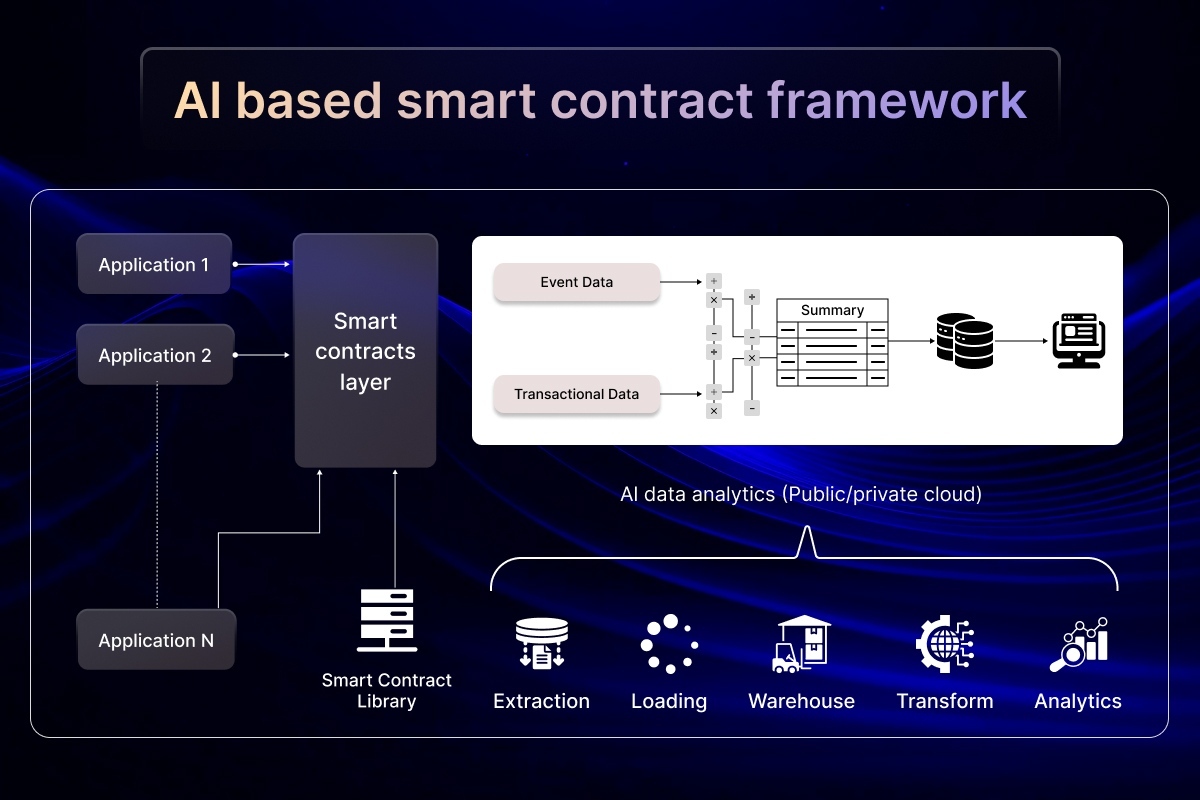
Benefits Over Traditional Smart Contracts
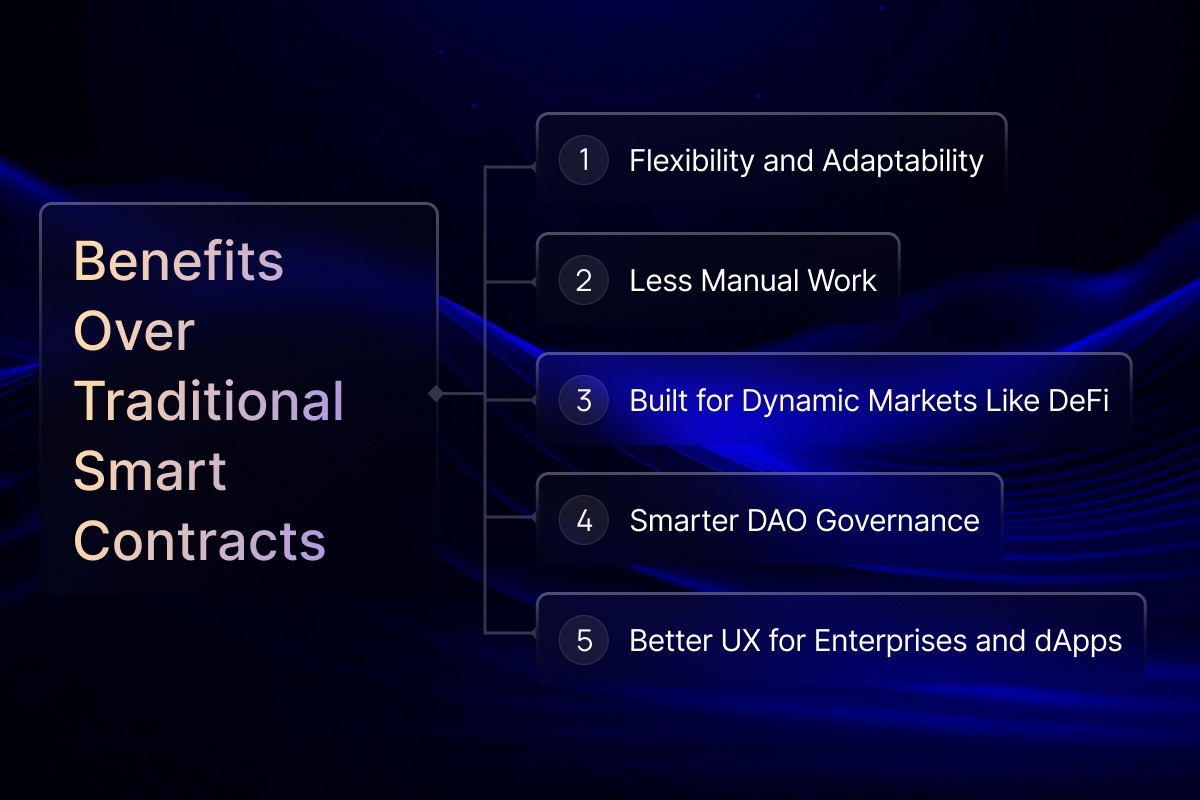
Intent-based contracts bring a set of clear advantages over the older, condition-heavy models. For teams building in fast-moving environments like DeFi or DAO frameworks, the difference is pretty significant.
Flexibility and Adaptability
Traditional contracts follow exact rules. Intent-based contracts can adjust based on context—making them more useful when things don’t go exactly as planned. This flexibility is a big plus for use cases where outcomes can vary.
Less Manual Work
With intent-driven logic and AI doing the heavy lifting, there's less need to manually tweak or redeploy contracts every time something changes. That means fewer updates, fewer errors, and faster iteration.
Built for Dynamic Markets Like DeFi
Markets shift constantly. Static logic can’t keep up. Automated smart contracts that read intent are better suited for use cases like yield optimization, asset rebalancing, or liquidity strategies in DeFi.
Smarter DAO Governance
Instead of voting on rigid proposals, DAOs can run actions that align with broad community goals. Intent-based smart contracts can help move things forward without getting stuck in technicalities—making DeFi governance smoother and more actionable.
Better UX for Enterprises and dApps
For businesses, fewer failed transactions and smarter automation mean a cleaner experience. Users don’t need to worry about every detail—contracts can take context into account and just get the job done.
For any serious smart contract development company, building with intent-based logic isn’t just a tech upgrade—it’s a smarter way to design automation for the real world.
Real-World Use Cases of Intent-Based Smart Contracts
Intent-based contracts aren’t just an interesting concept—they’re already starting to fit into real-world applications where static logic doesn’t go far enough. Here are a few clear examples where they bring real value:
Defi: Smarter Yield Strategies and Auto-Hedging
In DeFi automation, users often chase better yields or try to reduce risk during market swings. With intent-based contracts, a user can set a general goal—like maintaining stable returns—and let the contract figure out the best way to achieve it, whether that means moving funds, rebalancing assets, or auto-hedging against volatility.
Daos: Intent-Driven Governance
Instead of voting on predefined outcomes, DAOs can move toward intent-based voting, where proposals include broader goals. The contract can allocate funds or take actions that align with what the community actually wants, without needing new code for each vote.
Enterprises: Adaptive Supply Chain Automation
In business, things like weather delays or shipping issues can throw off standard contract flows. With enterprise smart contracts built on intent logic, those variables can be factored in. For example, if a shipment is late due to weather, payment terms can automatically adjust—no need for manual renegotiation.
RWA Tokenization: Context-Based Asset Distribution
In real-world asset tokenization, investor goals often vary. Intent-based contracts can manage auto-fractionalization or adjust distributions based on each user’s preferences—whether they’re aiming for long-term holding or regular yield.
All of these use cases point toward one thing: there’s a growing demand for smart contract development services that can handle complexity without adding friction. Intent-based contracts help make that possible.
AI’s Role in Smart Contract Evolution
AI isn’t just a buzzword anymore—it’s becoming a practical tool in how smart contracts work and respond to real-world inputs. As we head deeper into blockchain automation in 2025, the shift toward AI-driven smart contracts is picking up speed.
Types of AI Models Being Used
Different models play different roles:
-
Natural Language Processing (NLP): Helps interpret user intent when it’s expressed in plain language—think DAO votes or user commands.
-
Predictive analytics: Used to anticipate outcomes based on past data, like market trends in DeFi or user behavior in dApps.
-
Machine Learning (ML): Helps contracts adapt over time, getting better at making decisions as more data comes in.
Why Context Matters
Traditional smart contracts don’t really think—they just run code. But when you bring in AI, the contract can take context into account. It can look at recent price swings, user history, or even gas fees before deciding how to act. That’s what gives a smart contract with AI the ability to adjust on the fly, without needing to be rewritten.
Why It Matters in 2025
This kind of smart automation is starting to show up in more DeFi tools, DAO workflows, and enterprise systems. AI-driven contracts are being explored for everything from risk-managed DeFi strategies to automatic compliance in supply chains.
If you’re building for where things are going, not just where they are, this is the kind of thinking to get behind.
Challenges and Limitations
Intent-based smart contracts bring a lot of new possibilities, but they also come with a few things to watch out for. Like any new approach, there are trade-offs.
Understanding AI Decisions Isn’t Always Easy
One of the biggest challenges is interpretability. AI models—especially the more complex ones—don’t always give you a clear explanation for why they made a certain choice. In a smart contract environment, that lack of clarity can raise questions, especially when value or governance is involved.
Security Gets More Complex
With dynamic logic, security isn’t just about checking the code. It’s about understanding how that code might behave under different inputs. That makes secure smart contract development a bit more involved and puts more pressure on both developers and auditors. A proper smart contract audit becomes even more important when contracts can change behavior based on intent and context.
Governance and Auditability
Decentralized systems rely on transparency. If smart contracts are adjusting on the fly, it’s harder to keep track of what's actually happening. For DAOs or DeFi protocols, maintaining clear governance rules and audit trails is a challenge with intent-based logic.
It Needs the Right Infrastructure
Running AI models inside a blockchain environment isn’t simple. Most current networks aren’t built to support heavy compute or real-time context feeds. That means these contracts often need off-chain systems to process intent—which adds complexity to deployment and maintenance.
While these issues aren’t deal-breakers, they do require careful planning. Anyone working on intent-based smart contracts needs to think beyond just the code—they need to consider architecture, transparency, and long-term reliability.
The Future of Smart Contract Development
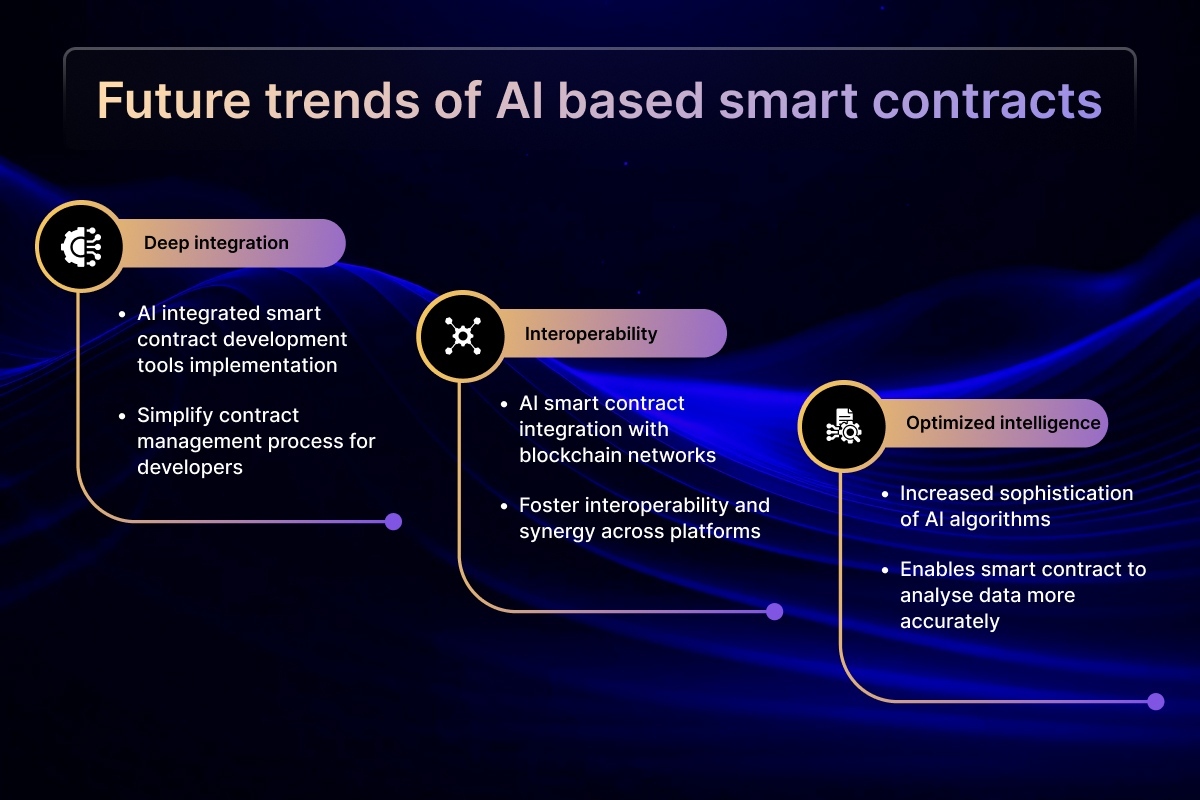
Smart contracts are no longer just about automating simple transactions. As we head into 2025, the focus is shifting toward smarter, context-aware systems that can actually think before they act.
Where Things Are Headed
We’re likely to see more adoption of intent-based logic—especially in areas like DeFi, DAOs, and tokenized real-world assets. Developers are already experimenting with ways to blend AI, oracles, and user intent into flexible contract execution. In short, the tools are catching up with the ideas.
Why Smart Contract Development Companies Matter
As things get more complex, it’s not just about writing good code anymore. A smart contract development company now has to think across multiple layers—data feeds, AI interpretation, user behavior, governance, and cross-chain compatibility. The teams that can piece all this together will set the pace for where smart contracts go next.
New Platforms Are Stepping In
We're seeing early-stage platforms starting to support intent-based frameworks by default. These aren't just Ethereum clones—they're built with smarter logic in mind. And as intent-based smart contracts become more common, we’ll likely see tooling and infrastructure catch up fast.
Bringing It All Together
Smart contract development trends in 2025 will revolve around interoperability, off-chain computation, and dynamic execution. AI will drive the logic, oracles will feed real-time data, and multi-chain support will make contracts more accessible across ecosystems.
For builders and businesses, now’s the time to rethink what a smart contract can actually do—and start planning for what's next.
Why Codezeros Is Leading This Evolution
At Codezeros, we’ve been ahead of the curve when it comes to building smarter smart contracts. Our team has been actively working on AI-integrated blockchain solutions—focusing on real use cases where intent-based logic actually makes a difference.
We’re not just experimenting. We’re building AI modules that plug directly into smart contract workflows, allowing for context-aware execution, dynamic automation, and intent interpretation at scale.
Whether it’s for a DeFi platform that needs automated yield logic or an enterprise client looking to streamline operations with custom blockchain automation, we deliver smart contract development services that go beyond static code. From strategy and architecture to writing and auditing contracts—we handle the entire flow.
If you’re looking for a smart contract development company that’s ready for what’s next, talk to us. We’ll help you build contracts that actually fit the way users and businesses work today.
Conclusion
Smart contracts are evolving. The shift from rigid, condition-based code to intent-based smart contracts is already underway—and it’s changing how developers and businesses approach blockchain automation.
With the rise of AI-driven smart contracts, we're seeing smarter automation, better decision-making, and more adaptable governance models—especially as we head into blockchain automation in 2025.
If you're building something that needs to move with context instead of fixed rules, now’s the time to rethink your approach. At Codezeros, we’re helping teams build contracts that work with intent—not against it.
Looking to get started?
Reach out to us and explore how our smart contract development services can fit into your next project.
FAQs
What is an intent-based smart contract?
An intent-based smart contract is one that executes based on what the user wants to achieve, rather than just following strict if-then rules. It uses AI and context to figure out the right way to act—making smart contract automation more flexible and useful.
How are AI-driven smart contracts different?
AI-driven smart contracts use models like NLP and machine learning to understand input and make real-time decisions. Traditional contracts only follow exact conditions, while AI-based ones adapt based on data and behavior.
Can I use intent-based smart contracts in DeFi?
Yes. Many DeFi platforms are exploring intent-based logic for things like auto-yield farming, risk management, and dynamic trading. It’s a natural fit for DeFi smart contract development where conditions change fast.
Are AI-based smart contracts secure?
They can be, but they do require extra attention during development and audits. Since logic can shift based on inputs, AI in smart contracts introduces new challenges that need to be covered during a smart contract audit.
Post Author

With a genuine love for all things blockchain, Jay is one of the Blockchain Enthusiasts and Consultants at Codezeros. With a fresh and innovative perspective on the world of blockchain, Jay provides strategic guidance and implementation support to clients across diverse industries and helps them unlock new opportunities.
Rethink automation with Codezeros’ AI-integrated smart contract development.
Looking to move beyond static logic? Our team helps you design, develop, and deploy smart contracts with adaptive execution powered by AI, external data feeds, and custom logic modules.

